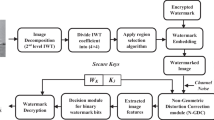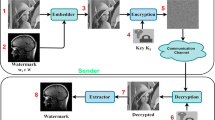Abstract
The ownership verification of digital images is possible by the help of image watermarking. Watermarking make the image secure towards unlawful use; but at the same time, it causes some information loss too. Medical and defense are few fields, where even a small change in data can be very problematic. So there is need of reliable and lossless watermarking schemes. The present study is focused on the development of lossless watermarking method that can fulfill five basic requirements (robustness, reversibility, invisibility, security and capacity) of ideal lossless watermarking scheme maximally. Arnold transformed watermark is embedded into the host to restrict any unauthorized access of watermark even after extraction. Slantlet transformed coefficients are known to be quite robust towards image processing attacks; so block wise Slantlet transform is employed to resist the maximum attacks and to ensure a decent capacity. Mean values of transformed coefficients are used for embedding to increase the robustness and imperceptibility. The spatial domain overflow/underflow (due to embedding) is taken care by a post processing to satisfy the reversibility requirements. The embedding strength of watermarking is controlled with the help of artificial bee colony (ABC) in order to get an optimal tradeoff between invisibility and robustness. The proposed scheme is applied to a range of images to show its applicability to different domains.












Similar content being viewed by others
References
Ali M, Ahn CW (2014) An optimized watermarking technique based on self-adaptive DE in DWT–SVD transform domain. Signal Process 94:545–556
Ali M, Ahn CW, Pant M (2014) A robust image watermarking technique using SVD and differential evolution in DCT domain. Optik-Int J Light Electron Optics 125(1):428–434
An L, Gao X, Li X, Tao D, Deng C, Li J (2012) Robust reversible watermarking via clustering and enhanced pixel-wise masking. IEEE Trans Image Process 21(8):3598–3611
An L, Gao X, Yuan Y, Tao D, Deng C, Ji F (2012) Content-adaptive robust lossless data embedding. Neurocomputing 79:1–11
An L, Gao X, Yuan Y, Tao D (2012) Robust lossless data hiding using clustering and statistical quantity histogram. Neurocomputing 77(1):1–11
An L, Gao X, Deng C (2010) Reliable embedding for robust reversible watermarking. Proc Sec Int Conf Internet Multimed Comput Service, Harbin, China 57–60
Ansari IA, Pant M (2015) SVD watermarking: particle swarm optimization of scaling factors to increase the quality of watermark. Proc Fourth Int Conf Soft Comput Problem Solv 205–214
Ansari IA, Pant M, Ahn CW (2015) SVD based fragile watermarking scheme for tamper localization and self-recovery. Int J Mach Learn Cybern. doi:10.1007/s13042-015-0455-1
Ansari IA, Pant A, Ahn CW (2016) Robust and false positive free watermarking in IWT domain using SVD and ABC. Eng Appl Artif Intell 49:114–125
Ansari IA, Pant M, Neri F (2014) Analysis of gray scale watermark in RGB host using SVD and PSO. IEEE Symp CIMSIVP 1–7
Celebi ME, Schaefer G (2013) Color medical image analysis. Lect Notes Comput Vision Biomech 6
De Vleeschouwer C, Delaigle J, Macq B (2001) Circular interpretation of histogram for reversible watermarking. Proc IEEE Fourth Workshop Multimed Sign Process 345–350
De Vleeschouwer C, Delaigle J, Macq B (2003) Circular interpretation of bijective transformations in lossless watermarking for media asset management. IEEE Trans Multimed 5(1):97–105
Draa A, Bouaziz A (2014) An artificial bee colony algorithm for image contrast enhancement. Swarm Evol Comput 16:69–84
J. Fridrich, M. Goljan, R. Du (2001) Invertible authentication. Proc SPIE Sec Watermark Multimed Content, San Jose, USA 197–208
Fridrich J, Goljan M, Du R (2002) Lossless data embedding — new paradigm in digital watermarking. EURASIP J Appl Sign Process 2:185–196
Gao X, An L, Li X, Tao D (2009) Reversibility improved lossless data hiding. Signal Process 89(10):2053–2065
Hanbay K, Talu MF (2014) Segmentation of SAR images using improved artificial bee colony algorithm and neutrosophic set. Appl Soft Comput 21:433–443
Haouzia A, Noumeir R (2008) Methods for image authentication: a survey. Multimed Tools Appl 39(1):1–46
Honsinger CW, Jones PW, Rabbani M, Stoffel JC (2001) Lossless recovery of an original image containing embedded data. US Patent no 6:278–791
Karaboga D (2005) An idea based on honey bee swarm for numerical optimization. Tech Rep TR06. Erciyes Univ Eng Fac Comput Eng Dep
Karaboga D, Akay B (2009) A comparative study of artificial bee colony algorithm. Appl Math Comput 214:108–132
Lagzian S, Soryani M, Fathy M (2011) A new robust watermarking scheme based on RDWT-SVD. Int J Intell Inform Process 2(1):22–29
Li YC, Yeh CM, Chang CC (2010) Data hiding based on the similarity between neighboring pixels with reversibility. Digit Sign Process 20(4):1116–1128
Lin W, Tao D, Kacprzyk J, Li Z, Izquierdo E, Wang H (2011) Multimedia analysis processing and communications 346
Macq (2000) Lossless multiresolution transform for image authenticating watermarking. Proc EUSIPCO 533–536
Makbol NM, Khoo BE (2014) A new robust and secure digital image watermarking scheme based on the integer wavelet transform and singular value decomposition. Digit Sign Process 33:134–147
Ni Z, Shi YQ, Ansari N, Su W, Sun Q, Lin X (2004) Robust lossless image data hiding. IEEE Int Conf Multimed Expo, Taipei, Taiwan 2199–2202
Ni Z, Shi YQ, Ansari N, Su W, Sun Q, Lin X (2008) Robust lossless image data hiding designed for semi-fragile image authentication. IEEE Trans Circ Syst Video Technol 18(4):497–509
Poljicak A, Mandic L, Agic D (2011) Discrete Fourier transform–based watermarking method with an optimal implementation radius. J Electron Imag 20(3):033008–033008
Potdar VM, Han S, Chang E (2005) A survey of digital image watermarking techniques. 3rd IEEE Int Conf Industr Inform INDIN’05 709–716
Ramanathan R, Kalaiarasi K, Prabha D (2013) Improved wavelet based compression with adaptive lifting scheme using artificial bee colony algorithm. Int J Adv Res Comput Eng Technol (IJARCET) 2(4):1549
Rawat S, Raman B (2011) A chaotic system based fragile watermarking scheme for image tamper detection. AEU Int J Electron Commun 65:840–847
Selesnick IW (1998) The slantlet transform. Proc IEEE-SP Int Symp Time-Freq Time-Scale Anal. Pittsburgh, PA 53–56
Selesnick IW (1999) The slantlet transform. IEEE Trans Signal Process 47(2):1304–1313
Sharma TK, Pant M, Ahn CW (2013) Improved food sources in artificial bee colony. IEEE Symp Swarm Intell (SIS) 95–102
Thabit R, Khoo BE (2014) Robust reversible watermarking scheme using Slantlet transform matrix. J Syst Softw 88:74–86
Thabit R, Khoo BE (2015) A new robust lossless data hiding scheme and its application to color medical images. Digital Sign Process 38:77–94
Wu L, Zhang J, Deng W, He D (2009) Arnold transformation algorithm and anti-Arnold transformation algorithm. 1st IEEE Int Conf Inform Sci Eng 1164–1167
Zou D, Shi Y, Ni Z, Su W (2006) A semi-fragile lossless digital watermarking scheme based on integer wavelet transform. IEEE Trans Circ Syst Video Technol 16(10):1294–1300
Zou D, Shi Y, Ni Z (2004) A semi-fragile lossless digital watermarking scheme based on integer wavelet transform. IEEE 6th Workshop Multimed Sign Process, Siena, Italy. 195–198
Acknowledgments
This research was supported by Basic Science Research Program through the National Research Foundation of Korea (NRF) funded by the Ministry of Science, ICT & Future Planning (NRF-2015R1D1A1A02062017).
Author information
Authors and Affiliations
Corresponding author
Rights and permissions
About this article
Cite this article
Ansari, I.A., Pant, M. & Ahn, C.W. Artificial bee colony optimized robust-reversible image watermarking. Multimed Tools Appl 76, 18001–18025 (2017). https://doi.org/10.1007/s11042-016-3680-z
Received:
Revised:
Accepted:
Published:
Issue Date:
DOI: https://doi.org/10.1007/s11042-016-3680-z




